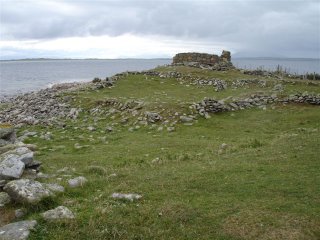This time its an older bird -N00069- who was originally caught in Portugal on 22nd May 1998, when it was taken taken out of the net by Rob and ringed by Fillippe Jorge (A Rocha assistant warden at the time).
The bird was re-caught this year, on 15th August 2006, at a large breeding colony on the island of Inishglora in the Republic of Ireland. A team of intrepid Irish storm petrellers caught an amazing 1,959 European stormies and 2 Leach's storm petrels in just 4 nights, including 1,022 in a single night! Its enough to make an Earthwatch storm petreller weep, since in Portugal this year we had several full nights when just one bird was caught and we are currently pretty pleased to get 20 birds in a night!
Views of Inishglora, where N00069 now breeds


The Irish team was masterminded by Neville McKee of Copeland Bird Observatory, with whom Renata and Rob met up last year at a seabird conference in Belfast. Along with Declan Clarke, Neville and his "vomit officer" George Henderson have kindly been collecting regurgitated food samples from Irish stormies for Renata's analysis of storm petrel diet.
The storm petrellers' camp site on Inishglora

Putting up the nets
 As N00069 would probably have been at least 2 years old when caught in Portugal, its current age is likely to be at least 10 years. This is a youngster however, compared to the 31 year old bird also retrapped this year on Inishglora. N00069 appeared to be breeding (as might be expected given its age), as it had a well-developed brood patch and weighed in at a hefty 30.3g.
As N00069 would probably have been at least 2 years old when caught in Portugal, its current age is likely to be at least 10 years. This is a youngster however, compared to the 31 year old bird also retrapped this year on Inishglora. N00069 appeared to be breeding (as might be expected given its age), as it had a well-developed brood patch and weighed in at a hefty 30.3g.Inishglora is a small rocky island with little vegetation, located off County Mayo in NW Eire. There are scattered boulder beaches along the edges, above the high water mark. The east end has the ruins of St Brendan the navigator’s ecclesiastical settlement (he may or may not have discovered America in the late 500s/early 600s AD -click here for more on the history and legends of Inishglora), and some more modern ruins including a near habitable bothy. Huge numbers of stormies breed among these boulders and ruins, and though the size of the population is hard to determine precisely, Neville estimates that the numbers are possibly in the upper part of the range 1,000 to 10,000 pairs.
Thanks to Neville for all the news, to his wife Pat for these photos and of course to George for the vomit samples!



